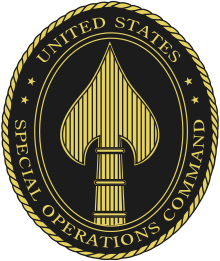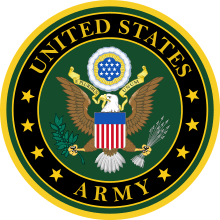United States Army Special Operations Command
| United States Army Special Operations Command (Airborne) | |
|---|---|
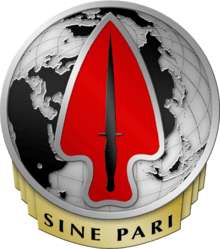 Distinctive unit insignia of USASOC Headquarters[1] | |
| Founded | 1 December 1989[2] |
| Country | |
| Branch | |
| Type | Special warfare operations |
| Role | Organize, train, educate, man, equip, fund, administer, mobilize, deploy and sustain U.S. Army special operations forces to successfully conduct worldwide special warfare operations. |
| Size | 33,805 personnel authorized:[3]
|
| Part of | |
| Headquarters | Fort Bragg, North Carolina, U.S. |
| Motto(s) | "Sine Pari" (Without Equal) |
| Engagements | Invasion of Panama Persian Gulf War Unified Task Force Operation Gothic Serpent Operation Uphold Democracy |
| Website | Official Website |
| Commanders | |
| Notable commanders | LTG Francis M. Beaudette (current) LTG Kenneth E. Tovo[2] Robert W. Wagner Edward M. Reeder Jr. John F. Mulholland Jr. Charles T. Cleveland |
| Insignia | |
| Combat service identification badge (CSIB) of the command, MISGs units and 1st SFOD-D | 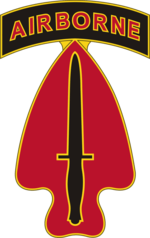 |
| Beret flash of the command | 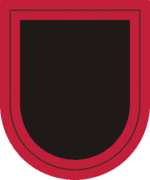 |
| Former distinctive unit insignia of the command (1990–2011) | .jpg) |


The United States Army Special Operations Command (Airborne) (USASOC) is the command charged with overseeing the various special operations forces of the United States Army. Headquartered at Fort Bragg, North Carolina, it is the largest component of the United States Special Operations Command. It is an Army Service Component Command. Its mission is to organize, train, educate, man, equip, fund, administer, mobilize, deploy and sustain Army special operations forces to successfully conduct worldwide special operations.
Subordinate units
1st Special Forces Command (Airborne)

The ![]()
![]()
Special Forces Groups
Established in 1952, the Special Forces Groups, also known as the Green Berets, was established as a special operations force of the United States Army designed to deploy and execute nine doctrinal missions: unconventional warfare, foreign internal defense, direct action, counter-insurgency, special reconnaissance, counter-terrorism, information operations, counterproliferation of weapon of mass destruction, and security force assistance.[6] These missions make special forces unique in the U.S. military because they are employed throughout the three stages of the operational continuum: peacetime, conflict, and war.[7] Often SF units are required to perform additional, or collateral, activities outside their primary missions. These collateral activities are coalition warfare/support, combat search and rescue, security assistance, peacekeeping, humanitarian assistance, humanitarian de-mining, and counter-drug operations.[7] Their unconventional warfare capabilities provide a viable military option for a variety of operational taskings that are inappropriate or infeasible for conventional forces, making it the U.S. military's premier unconventional warfare force.[7]
Today, there are seven special forces groups: ![]()
![]()
![]()
![]()
![]()
![]()
![]()
Psychological Operations Groups
The mission of the ![]()
![]()
Psychological operations is a part of the broad range of U.S. political, military, economic and ideological activities used by the U.S. government to secure national objectives. Used during peacetime, contingencies and declared war, these activities are not forms of force, but are force multipliers that use nonviolent means in often violent environments. Persuading rather than compelling physically, they rely on logic, fear, desire or other mental factors to promote specific emotions, attitudes or behaviors.[8]
The ultimate objective of U.S. PSYOP is to convince enemy, neutral, and friendly nations and forces to take action favorable to the United States and its allies. The ranks of the PSYOP include regional experts and linguists who understand political, cultural, ethnic and religious subtleties and use persuasion to influence perceptions and encourage desired behavior. With functional experts in all aspects of tactical communications, PSYOP offers joint force commanders unmatched abilities to influence target audiences as well as strategic influence capabilities to U.S. diplomacy.[8]
In addition to supporting commanders, PSYOP units provide interagency strategic influence capabilities to other U.S. government agencies. In operations ranging from humanitarian assistance to drug interdiction, PSYOP enhances the impact of those agencies’ actions. Their activities can be used to spread information about ongoing programs and to gain support from the local populace.[8]
95th Civil Affairs Brigade (Airborne)
The ![]()
They help host nations assess the needs of an area, bring together local and non-local resources to ensure long-term stability, and ultimately degrade and defeat violent extremist organizations and their ideologies. They may be involved in disaster prevention, management, and recovery, and with human and civil infrastructure assistance programs.[10]
The 95th Civil Affairs Brigade (Airborne) conducts its mission via five operational battalions: ![]()
![]()
![]()
![]()
![]()
528th Sustainment Brigade (Airborne)
The ![]()
Headquartered at Fort Bragg, North Carolina, the 528th Sustainment Brigade (Airborne) sets the operational level logistics conditions to enable Army Special Operation Forces (ARSOF) operations worldwide using three ARSOF Support Operations Teams (ASPOs), three Special Operations Resuscitation Teams (SORT), five ARSOF Liaison Elements (ALE), two Medical Level II teams and ![]()
The brigade has the capability of providing technical control to multiple Special Forces group support battalions in the planning and execution of ARSOF combat service support and combat health support. The 528th Sustainment Brigade (Airborne) is capable of deploying three Army Support Operations Teams in support of three ARSOF-based Special Operations Task Forces or a SOF-based JTF. The Support Operations Team initially co-locates with the group support battalion or a Ranger support operations detachment and provides ARSOF with an in-theater presence providing centralized and integrated material management of property, equipment maintenance, logistical automation and repair parts and supplies.[11]
ARSOF Liaison Elements soldiers are embedded in Army regional theaters’ staff. They plan and coordinate with theater Army, Special Operations Command and Army Special Operations Command to ensure support during operations and training. As a theater Army staff member, these officers and non-commissioned officers’ knowledge of theater-specific requirements and capabilities assist units in coordination with the theater.[11]
The medical section provides Level II medical support as USASOC asset managed by the brigade surgeon and constitutes the nucleus of the capability of receiving a conventional Army Forward Surgical Team. The medical section is robust enough to provide combat health support on an area basis for approximately 450 personnel. The support includes unit-level medical support and health services, logistics, emergency medical and resuscitative treatment for all classes of patients; emergency dental treatment, physical therapy and preventive medicine support, while maintaining Standard Army Management Information Systems and providing veterinary support.[11][12]
Members of the 112th Special Operations Signal Battalion (Airborne) specialize in communication and force sustainment skills, employing innovative telecommunications technologies to provide Army Special Operations Task Force commanders with secure and nonsecure voice, data and video services. In their respective fields, signal and support soldiers provide oversight of material distribution management, synchronization, and integrated material management of property accountability, maintenance management and logistics automation for deployed ARSOF. Communications expertise allows ARSOF to "shoot, move and communicate" on a continuous basis. Soldiers assigned to ARSOF units are taught to operate and maintain a vast array of unique equipment not normally used by their conventional counterparts. To meet the needs of ARSOF, the Sustainment Brigade has developed logistical and signal packages that are rapidly deployable on a moment's notice. Soldiers assigned to these units are airborne qualified.[11]
The 528th Sustainment Brigade embodies its motto of "We Support to the Utmost," providing the means to effectively and efficiently execute logistics in support of ARSOF operations.[11]
U.S. Army Special Operations Aviation Command (Airborne)
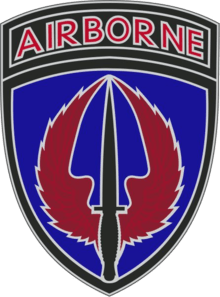
The ![]()
![]()
The 160th Special Operations Aviation Regiment (Airborne), newly subordinate to ARSOAC,[14] provides aviation support to special operations forces. Known as "Night Stalkers," these soldiers are recognized for their proficiency in nighttime operations striking undetected during the hours of darkness and are recognized as the pioneers of the US Army's nighttime flying techniques. Today, Night Stalkers continue to develop and employ new technology and tactics, techniques and procedures for the battlefield. They employ highly modified heavy assault versions of the MH-47 Chinook, medium assault and attack versions of the MH-60 Black Hawk, light assault and attack versions of the MH-6 Little Bird helicopters,[15] and MQ-1C Gray Eagles via four battalions, two Extended-Range Multi-Purpose (ERMP) companies, a headquarters company, and a training company. The ![]()
![]()
![]()
![]()
75th Ranger Regiment
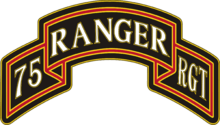
The ![]()
![]()
![]()
![]()
Within the US special operations community, the 75th Ranger Regiment is unique with its ability to attack heavily defended targets of interest. The regiment specializes in air assault, direct action raids, seizure of key terrain (such as airfields), destroying strategic facilities, and capturing or killing high-profile individuals. Each BN of the regiment can deploy anywhere in the world within 18 hours' notice. Rangers are capable of conducting squad through regimental-size operations using a variety of insertion techniques including airborne, air assault, and ground infiltration. The regiment is an all-volunteer force with an intensive screening and selection process followed by combat-focused training. Rangers are resourced to maintain exceptional proficiency, experience and readiness.[17]
U.S. Army John F. Kennedy Special Warfare Center and School
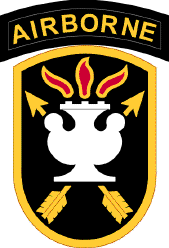
The ![]()
On any given day, approximately 3,100 students are enrolled in SWCS training programs. Courses range from entry-level training to advanced warfighter skills for seasoned officers and NCOs. The ![]()
![]()
![]()
![]()
![]()
1st Special Forces Operational Detachment-Delta

The 1st Special Forces Operational Detachment-Delta (1st SFOD-D), commonly referred to as Delta Force, Combat Applications Group (CAG), "The Unit", Army Compartmented Element, or within the Joint Special Operations Command (JSOC) as Task Force Green,[19] is an elite special mission unit of the United States Army, under the organization of USASOC but is controlled by JSOC. It is used for hostage rescue and counterterrorism, as well as direct action and reconnaissance against high-value targets. 1st SFOD-D and its U.S. Navy and U.S. Air Force counterparts, DEVGRU, "SEAL Team 6", and the 24th Special Tactics Squadron, perform the most highly complex and dangerous missions in the U.S. military. These units are also often referred to as "Tier One" and "special mission units" by the U.S. government.
Order of Battle

List of commanders
- LTG Peter Schoomaker, October 1996 – 1997[20]
- LTG William Tangney, 1997 – 11 October 2000
- LTG Bryan D. Brown, 11 October 2000 – 29 August 2002
- LTG Philip R. Kensinger Jr., 29 August 2002 – 8 December 2005
- LTG Robert W. Wagner, 8 December 2005 – 7 November 2008
- LTG John F. Mulholland Jr., 7 November 2008 – 24 July 2012[21]
- LTG Charles T. Cleveland, 24 July 2012 – 1 July 2015
- LTG Kenneth E. Tovo, 1 July 2015 – 12 June 2018
- LTG Francis M. Beaudette, 12 June 2018 – present
References
- U.S. Army Special Operations Command, Distinctive Unit Insignia, United States Army Institute of Heraldry, last accessed 12 February 2017
- SOCOM Fact Book 2014 (PDF). SOCOM Public Affairs. 2014. Archived from the original (PDF) on 4 December 2013. Retrieved 17 December 2015.
- http://www.gao.gov/assets/680/671462.pdf
- "Special Forces Shoulder Sleeve Insignia". soc.mil. Retrieved 23 March 2019.
- Trevithick, Joseph (26 November 2014). "The U.S. Army Has Quietly Created a New Commando Division". Medium.com. Retrieved 25 February 2015.
- Army Special Operations Forces Fact Book 2018, USASOC official website, dated 2018, last accessed 28 July 2019
- U.S. Army Special Forces Command. Soc.mil. Archived from the original on 20 December 2010. Retrieved 17 December 2015.
- "MISOC Units Re-designate as PSYOP – ShadowSpear Special Operations". Shadowspear.com. 13 December 2015. Retrieved 17 December 2015.
- The Army's psychological operations community is getting its name back, Army Times, by Meghann Myers, dated 6 November 2017, last accessed 4 March 2018
- 95th Civil Affairs Brigade. Soc.mil. Retrieved 17 December 2015.
- 528th Sustainment Brigade. Soc.mil. Retrieved 17 December 2015.
- Jamie Riesberg (2009). "The Special Operations Resuscitation Team: Robust Role II Medical Support for Today's SOF Environment" (PDF). Journal of Special Operations Medicine. 9. Retrieved 26 January 2014.
- Archived 14 October 2013 at the Wayback Machine
- "Night Stalkers mark new lineage with donning of USASOAC patch | Article | The United States Army". Army.mil. 3 October 2013. Retrieved 17 December 2015.
- 160th Special Operations Aviation Regiment (Airborne), soc.mil, last accessed 9 October 2016
- Army's Elite Night Stalkers Quietly Stood Up A New Unit Ahead Of Getting New Drones, thedrive.com, By Joseph Trevithick, dated 8 February 2019, last accessed 12 February 2019
- 75th Ranger Regiment, The Army's Premier Raid Force, United States Army Special Operations Command Homepage, last accessed 20 May 2017
- About SWCS. Soc.mil. Retrieved 17 December 2015.
- Naylor, Sean. Relentless Strike. Chapter 4.CS1 maint: location (link)
- "Peter Jan Schoomaker". History.army.mil. Retrieved 17 December 2015.
- "Archived copy". Archived from the original on 29 June 2013. Retrieved 30 April 2013.CS1 maint: archived copy as title (link)
External links
| Wikimedia Commons has media related to United States Army Special Operations Command. |
